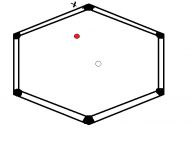Stan, I was able to adopt CTE Pro One for some shots and I use it 100% for bank shots. It’s much easier than trying to count diamonds.
I do not have problem with understanding which lines to use (A,B,C or others). I understand what sweep to use (I or O) and can perform it, have a foot work I like. However, I am still straggling with perception. For me, I have a hard time to align with 2 lines. If it was just one line, like in 1/8 overlap I would just stay behind it and sweep. However, with two lines unless CB and OB are of certain distance range, I cannot see lines coming from my focal point and go via proper points. What I see is asymmetric trapezium, e.g. CBE-A-OBE-CBC and I have to memorize it for each shot, which I do not like.
I remember in one video you mentioned you did not have to do it with CTE Pro One. What do I miss? Can someone describe what the shape looks like? Maybe I just CTE Pro One blind, like some people are color blind? I wish there was some 3D picture of what exactly I have to see. Again, for now I substitute it by memorizing the shapes for different shots but I would like to improve it. Is there any workaround of it?
